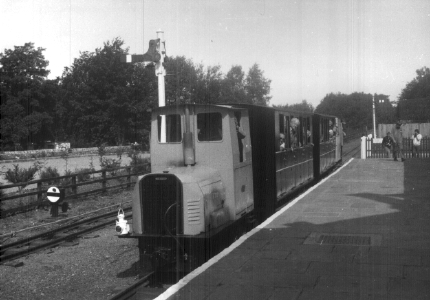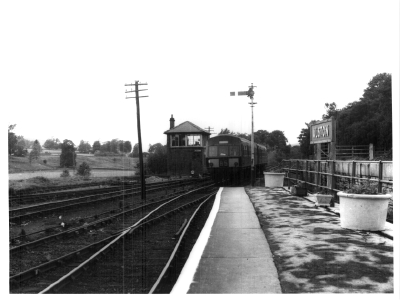 |
and the Haltwhistle to Alston branch line |
 |
and the Haltwhistle to Alston branch line |
The South Tynedale Railway 
Photo: The first narrow gauge train arrives at Alston Station from Gilderdale on Saturday 30th July 1983, hauled by Hibberd diesel locomotive No.1 "Phoenix". (Dr. Thomas M. Bell)
The Alston branch of the Newcastle and Carlisle Railway had a stormy, if somewhat protracted, birth before settling down to serve the communities of the South Tyne valley for over one hundred years. A candidate for closure even before Beeching welded his axe, it fought back successfully, only to succumb 13 years later, eventually closing in the evening of Saturday 1st May 1976, when the construction of a new road allowed the establishment of a replacement bus service.
The initial plans to preserve the line intact unfortunately came to nought, but from the ashes of this failure the South Tynedale Railway Preservation Society (STRPS) seized the opportunity to construct a 2 foot narrow gauge line on the standard gauge trackbed. Following a successful inspection by the Department of Transport inspecting officer the previous day, passenger services started along a one mile stretch of line from Alston to a temporary terminus, named Gilderdale Halt, on Saturday 30th July 1983, and the line was extended by a further half mile to a new Gilderdale station, near the Northumberland/Cumbria county boundary in December 1986.
The Society�s first steam locomotive entered regular service in July 1987, and on 23rd August that year the then Patron of the Society, the Earl of Carlisle, named this locomotive �Thomas Edmondson�, after the inventor of the ticket system used by British railways for over 150 years.
With a fully equipped engine shed and carriage works established at Alston, the Society has extended the railway into Northumberland and the first section from Gilderdale to Kirkhaugh opened to passenger trains on Saturday 4th September 1999, following a very successful inspection by the H.M. Government�s railway inspectorate on Friday 27th August 1999. A light railway order has been obtained to cover the future construction of the line northwards from Kirkhaugh to Slaggyford, subject to the finalisation of a lease of the trackbed by both Northumberland County Council and Tynedale District Council.
The Haltwhistle to Alston Branch Line
Photo: Alston Station in the 1950s. (From the N.E. Stead Collection)
During the 19th century, the area around Alston, known as Alston Moor was an important lead mining district, producing up to 10,000 tons of metal per annum. From the start, all proposals to connect the River Tyne with the Solway Coast, first by canal in 1794, and then by rail in 1825, expected the lead mines of the north Pennines to be a major source of traffic. Although the turnpike roads connecting Alston Moor with the neighbouring towns had been improved by McAdam in the 1820s, two of the pioneering railway companies turned their attention to the mineral wealth of the South Tyne valley in 1845.
A 17 mile branch line from Haltwhistle to Nenthead was proposed by the Newcastle and Carlisle Railway Company, which first connected the east and west coasts of Britain when it opened its main line from the Tyne at Redheugh to Carlisle canal basin on 18th June 1838. To the south, subsidiaries of the Stockton and Darlington Railway Company were steadily progressing up the valley of the River Wear, and the Wear Valley Extension Railway was projected to construct a 38 mile line from Frosterley to Milton (the present Brampton station) on the Carlisle line, passing through Nenthead and Alston. This would have been a truly great monument to the early railway engineers, with massive earth works up the Wear Valley culminating in a summit level of 1,525 feet, followed by a 2¼ mile tunnel under Killhope to reach the valley of the River Nent.
The proposed routes from Nenthead to Lambley followed similar, but not identical alignments and would have passed high above Alston town on the eastern hillside, crossing the Hexham road (A686) near Low Byer Manor Hotel. From Lambley, the Newcastle line continued north to Haltwhistle, while the Darlington plans show a main line running westwards, about one mile to the north of Lord Carlisle�s Railway, to which a branch was to be built at Halton Lea Gate. Both sets of plans were submitted to Parliament in November 1845, but within a month, the Wear Valley Company had decided not to proceed, due to the prevailing economic climate. Despite a major Parliamentary battle, the Newcastle and Carlisle Railway Act, authorising construction of their line, received the Royal Assent on 26th August 1846. There then followed a period of masterly inactivity, whilst various proposals were made to modify the route.
The original plans included a crossing of the River Tyne at Lambley to enable a connection to be made with Lord Carlisle�s Railway. In 1847 the Railway proposed to eliminate this crossing, thereby going back on their arrangement with Lord Carlisle who had supported the Newcastle scheme in preference to the Darlington line. Finally on 13th July 1849, Parliament approved a modified line which abandoned the steeply graded Nenthead section. This also enabled the last 1½ miles to be constructed on a much improved alignment, terminating conveniently at the foot of the town of Alston. A 1½ mile �branch of the branch� was also authorised to run from Lambley station to join Lord Carlisle�s Railway at Halton Lea Gate. In the event, only the first ¾ mile to Lambley colliery was built by the Railway Company, the remainder was constructed as the final eastward extension of Lord Carlisle�s Railway in 1849.
Construction proceeded fairly rapidly and the first 4¼ miles from Haltwhistle to Shafthill (later known as Coanwood) were opened for goods in March, and for passengers on 9th July 1851. The southern section of 9 miles to Alston from Lambley colliery was brought into use for goods and mineral traffic on 5th January 1852, and the whole branch was opened to all traffic on 17th November that same year, with the completion of the ½ mile link over the Lambley viaduct from Shafthill to Lambley station.
Steep gradients of up to 1 in 56 were required to lift the line 500 feet in 13 miles, while heavy earthworks abounded, and no less than nine viaducts were constructed to carry the rails over the River South Tyne and its tributaries. Sufficient land was taken for double track, but this was never required and the line remained single to the end.
At least six proposals to extend the line southwards were made between 1870 and 1891. Five of these revised the Wear Valley route, but the only scheme to reach the stage of a submission to Parliament was the Cumberland and Cleveland Junction Railway, whose plans were deposited on 30th November 1871. This 25 mile line to Middleton-in-Teesdale was intended to leave the Alston branch north of the station, close to where the narrow gauge engine shed now stands. It was then to follow the west side of the South Tyne valley to a summit of about 1,900 feet above sea level , before dropping into the valley of the River Tees. In the end no further extensions were built and, indeed, the one intermediate connection was severed in 1909 when Lord Carlisle�s Railway was lifted beyond Halton Lea Gate.
For most of its life of 124 years traffic on the Alston branch was handled by a single locomotive stationed at Alston, but between 1928 and 1957 a second locomotive was required. The first economies in the running of the branch came in 1955 when the intermediate stations became unstaffed halts and goods traffic to and from Coanwood ceased. Although Alston station handled 15,000 tons of freight in 1953, the closure of the last colliery at Lambley in 1958 heralded the beginning of the end. Freight services were withdrawn from Lambley and Slaggyford in 1960, from Featherstone Park in 1963 and from Alston in 1965. Diesel multiple units operating from Blaydon shed had taken over the passenger services in 1959, allowing the engine shed at Alston to close, whilst the cessation of freight traffic enabled the signalling equipment on the branch to be abandoned.

Withdrawal of all passenger trains between Haltwhistle and Alston was under consideration even before the formulation of the Beeching Report of 1963, but the branch was reprieved on the grounds that closure would cause severe hardship to the population of the South Tyne valley. Nevertheless, the end finally came on Saturday 1st May 1976, when the opening of a new road connecting Lambley with Coanwood enabled a replacement bus service to commence operating the following Monday.
Photo: British Rail 2 car Diesel Multiple Unit enters Alston Station in the 1960s (From the N.E. Stead Collection).
The information contained on this page has been based on the booklet entitled �The South Tynedale Railway - Visitors Guide� by Thomas M. Bell. The fourth edition of the booklet is now available, price £2.00 each, excluding postage, from Alston Railway Station shop.
For more information about the South Tynedale Railway, please contact:-
SOUTH TYNEDALE RAILWAY PRESERVATION SOCIETY
The Railway Station, Alston, Cumbria, CA9 3JB.
Tel. 01434 381696. Talking timetable tel. 01434 382828.E-mail enquiries - please click on links below:
South Tynedale Railway information - Send e-mail to South Tynedale Railway
STRPS membership information only - Send e-mail to Kathy Aveyard
Tynedalesman information only - Send e-mail to Tynedalesman compilersThis page was last updated on 3rd January 2006.
©South Tynedale Railway Preservation Society 2006.